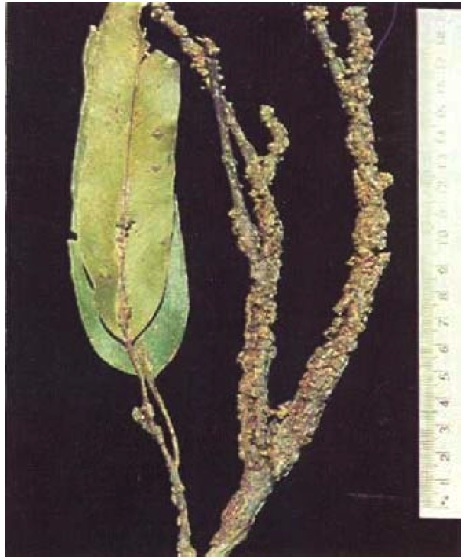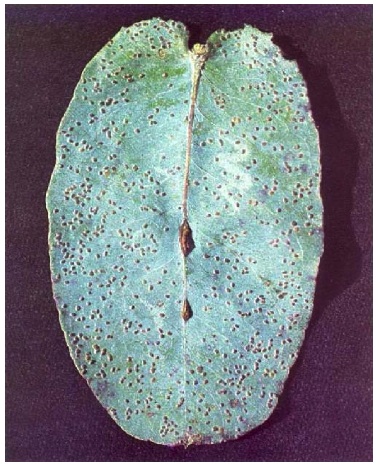PESTS AND DISEASES OF FORESTRY IN NEW ZEALAND
Blue-gum chalcid
Scion is the leading provider of forest-related knowledge in New Zealand
Formerly known as the Forest Research Institute, Scion has been a leader in research relating to forest health for over 50 years. The Rotorua-based Crown Research Institute continues to provide science that will protect all forests from damage caused by insect pests, pathogens and weeds. The information presented below arises from these research activities.
Forest and Timber Insects in New Zealand No. 15: Blue-gum Chalcid.
Revised 2003
Based on J. Bain (1977).
Insect: Ophelimus sp.* (Gahan) (Hymenoptera: Chalcidoidea: Eulophidae)
*Formerly known as Rhicnopeltella eucalypti.

Fig. 1 - Gnarled appearance of twigs caused by galls induced by larvae of the blue-gum chalcid.
Type of injury
The larvae of the blue-gum chalcid induce galls to form on twigs and leaves of the host (Fig. 1 and 2).
Hosts
Eucalyptus globulus and other species of similar succulent growth are hosts to this chalcid.
Distribution
This Australian insect occurs throughout New Zealand wherever the hosts are found.
Economic importance
The blue-gum chalcid is one of the most important pests on E. globulus in New Zealand. Repeated attack can lead to loss of foliage from terminal branches and even large limbs, and possibly to the death of the tree.
Description, life history, and habits
The adult is a very small (1.0-1.5 mm long) black wasp. The larva is a minute, white, legless grub found within the galls on the host plant. There is generally believed to be one generation per year, with adults being found from December to February. However, Clark (1938) records two emergence periods, viz. December-January and June-July. Oviposition occurs soon after emergence. The eggs are laid singly in the young bark of the twigs, in the midribs of the leaves, or in the actual leaf blades. When the eggs are laid in the twigs or in the midribs of the leaves the developing larvae induce coalescing swellings, or galls, to form on the host plant tissue. After repeated attacks the young growth has a gnarled appearance. These galls can cause the twigs to split, destroying the cambium. When the eggs are laid in the leaf tissue, the resulting "pimple" galls are well separated from each other. The adults that emerge from the pimple galls are always much smaller than those that emerge from the twig galls.

Fig. 2 - "Pimple" galls caused by the blue-gum chalcid on a leaf of Eucalyptus globulus.
The larvae pupate within the galls and the adults emerge through a tiny hole that they cut to the surface.
Control
Control of this insect has not been attempted in New Zealand but should be feasible (if justified economically) with a systemic insecticide.
References
Bain. J. 1977: Rhicnopeltella eucalypti Gahan (Hymenoptera: Chalcidoidea: Eulophidae), Blue-gum Chalcid. New Zealand Forest Service, Forest and Timber Insects in New Zealand No. 15.
Clark, A.F. 1938: A survey of the insect pests of eucalypts in New Zealand. New Zealand Journal of Science and Technology 19: 750-761.
Cottier, W. 1956: Insect Pests. Pp. 209-481 in Atkinson, J.1). et al. "Plant Protection in New Zealand". Government Printer, Wellington, New Zealand.
Miller, D. 1921: The gall chalcid of blue-gum. A preliminary note. New Zealand Journal of Agriculture 23: 282-283.
Valentine, E.W. 1970: A list of phytophagous Hymenoptera in New Zealand. New Zealand Entomologist 4 (4): 52-62.
This information is intended for general interest only. It is not intended to be a substitute for specific specialist advice on any matter and should not be relied on for that purpose. Scion will not be liable for any direct, indirect, incidental, special, consequential or exemplary damages, loss of profits, or any other intangible losses that result from using the information provided on this site.
(Scion is the trading name of the New Zealand Forest Research Institute Limited.)

 Farm Forestry New Zealand
Farm Forestry New Zealand

